Foresight Project: Virtual Learning Space and Future Trends
VerifiedAdded on 2023/01/11
|14
|4856
|91
Project
AI Summary
This foresight project examines the application of digital technologies within virtual learning spaces, defining such spaces and evaluating their current uses and potential flaws. The project identifies a preferred future for virtual learning, emphasizing interactive and creative environments that enhance student skills and engagement. It then employs backcasting to analyze the pedagogical, social, and cultural changes required to achieve this future. The analysis covers mapping, anticipation, timing, deepening, creating alternatives, and transforming, highlighting the need for shifts in educational practices, social structures, and cultural perspectives to integrate technology effectively. The project also addresses potential challenges like lack of discipline, privacy concerns, and dependence on technology, proposing solutions to promote a balanced and effective learning experience. The project concludes by emphasizing the importance of adapting teaching methods and fostering a supportive online learning environment.

Foresight Project
Paraphrase This Document
Need a fresh take? Get an instant paraphrase of this document with our AI Paraphraser
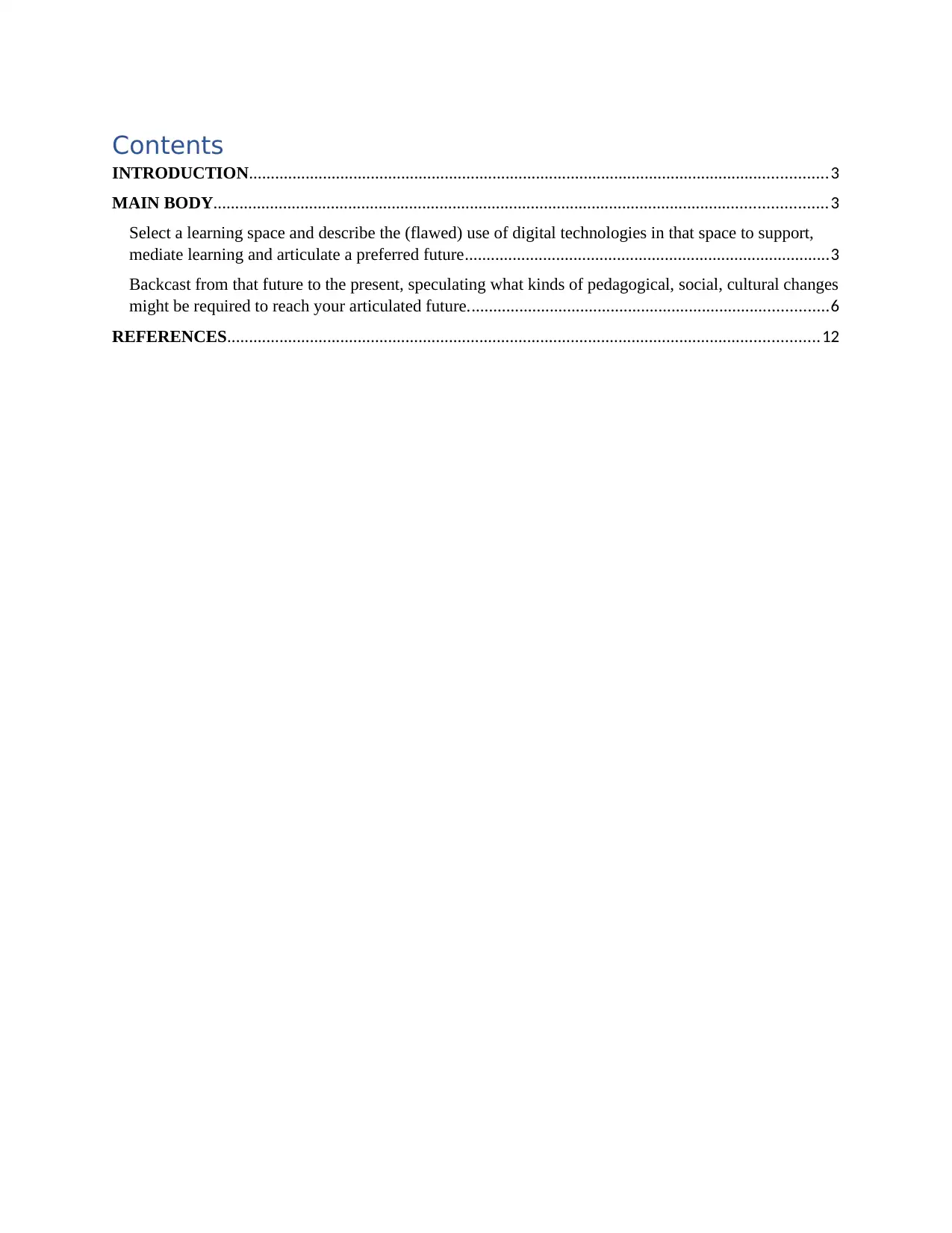
Contents
INTRODUCTION.....................................................................................................................................3
MAIN BODY.............................................................................................................................................3
Select a learning space and describe the (flawed) use of digital technologies in that space to support,
mediate learning and articulate a preferred future....................................................................................3
Backcast from that future to the present, speculating what kinds of pedagogical, social, cultural changes
might be required to reach your articulated future...................................................................................6
REFERENCES........................................................................................................................................12
INTRODUCTION.....................................................................................................................................3
MAIN BODY.............................................................................................................................................3
Select a learning space and describe the (flawed) use of digital technologies in that space to support,
mediate learning and articulate a preferred future....................................................................................3
Backcast from that future to the present, speculating what kinds of pedagogical, social, cultural changes
might be required to reach your articulated future...................................................................................6
REFERENCES........................................................................................................................................12
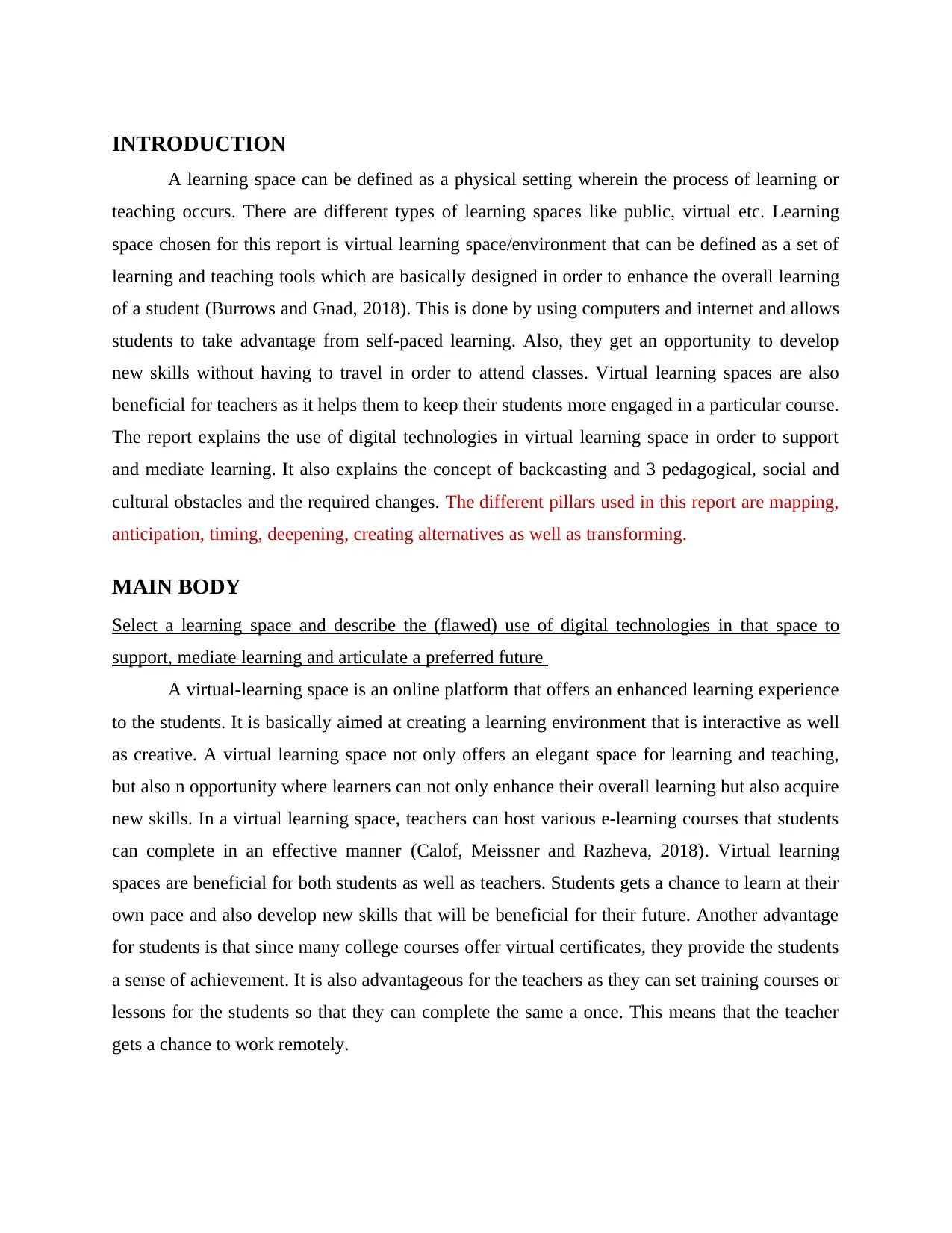
INTRODUCTION
A learning space can be defined as a physical setting wherein the process of learning or
teaching occurs. There are different types of learning spaces like public, virtual etc. Learning
space chosen for this report is virtual learning space/environment that can be defined as a set of
learning and teaching tools which are basically designed in order to enhance the overall learning
of a student (Burrows and Gnad, 2018). This is done by using computers and internet and allows
students to take advantage from self-paced learning. Also, they get an opportunity to develop
new skills without having to travel in order to attend classes. Virtual learning spaces are also
beneficial for teachers as it helps them to keep their students more engaged in a particular course.
The report explains the use of digital technologies in virtual learning space in order to support
and mediate learning. It also explains the concept of backcasting and 3 pedagogical, social and
cultural obstacles and the required changes. The different pillars used in this report are mapping,
anticipation, timing, deepening, creating alternatives as well as transforming.
MAIN BODY
Select a learning space and describe the (flawed) use of digital technologies in that space to
support, mediate learning and articulate a preferred future
A virtual-learning space is an online platform that offers an enhanced learning experience
to the students. It is basically aimed at creating a learning environment that is interactive as well
as creative. A virtual learning space not only offers an elegant space for learning and teaching,
but also n opportunity where learners can not only enhance their overall learning but also acquire
new skills. In a virtual learning space, teachers can host various e-learning courses that students
can complete in an effective manner (Calof, Meissner and Razheva, 2018). Virtual learning
spaces are beneficial for both students as well as teachers. Students gets a chance to learn at their
own pace and also develop new skills that will be beneficial for their future. Another advantage
for students is that since many college courses offer virtual certificates, they provide the students
a sense of achievement. It is also advantageous for the teachers as they can set training courses or
lessons for the students so that they can complete the same a once. This means that the teacher
gets a chance to work remotely.
A learning space can be defined as a physical setting wherein the process of learning or
teaching occurs. There are different types of learning spaces like public, virtual etc. Learning
space chosen for this report is virtual learning space/environment that can be defined as a set of
learning and teaching tools which are basically designed in order to enhance the overall learning
of a student (Burrows and Gnad, 2018). This is done by using computers and internet and allows
students to take advantage from self-paced learning. Also, they get an opportunity to develop
new skills without having to travel in order to attend classes. Virtual learning spaces are also
beneficial for teachers as it helps them to keep their students more engaged in a particular course.
The report explains the use of digital technologies in virtual learning space in order to support
and mediate learning. It also explains the concept of backcasting and 3 pedagogical, social and
cultural obstacles and the required changes. The different pillars used in this report are mapping,
anticipation, timing, deepening, creating alternatives as well as transforming.
MAIN BODY
Select a learning space and describe the (flawed) use of digital technologies in that space to
support, mediate learning and articulate a preferred future
A virtual-learning space is an online platform that offers an enhanced learning experience
to the students. It is basically aimed at creating a learning environment that is interactive as well
as creative. A virtual learning space not only offers an elegant space for learning and teaching,
but also n opportunity where learners can not only enhance their overall learning but also acquire
new skills. In a virtual learning space, teachers can host various e-learning courses that students
can complete in an effective manner (Calof, Meissner and Razheva, 2018). Virtual learning
spaces are beneficial for both students as well as teachers. Students gets a chance to learn at their
own pace and also develop new skills that will be beneficial for their future. Another advantage
for students is that since many college courses offer virtual certificates, they provide the students
a sense of achievement. It is also advantageous for the teachers as they can set training courses or
lessons for the students so that they can complete the same a once. This means that the teacher
gets a chance to work remotely.
⊘ This is a preview!⊘
Do you want full access?
Subscribe today to unlock all pages.

Trusted by 1+ million students worldwide
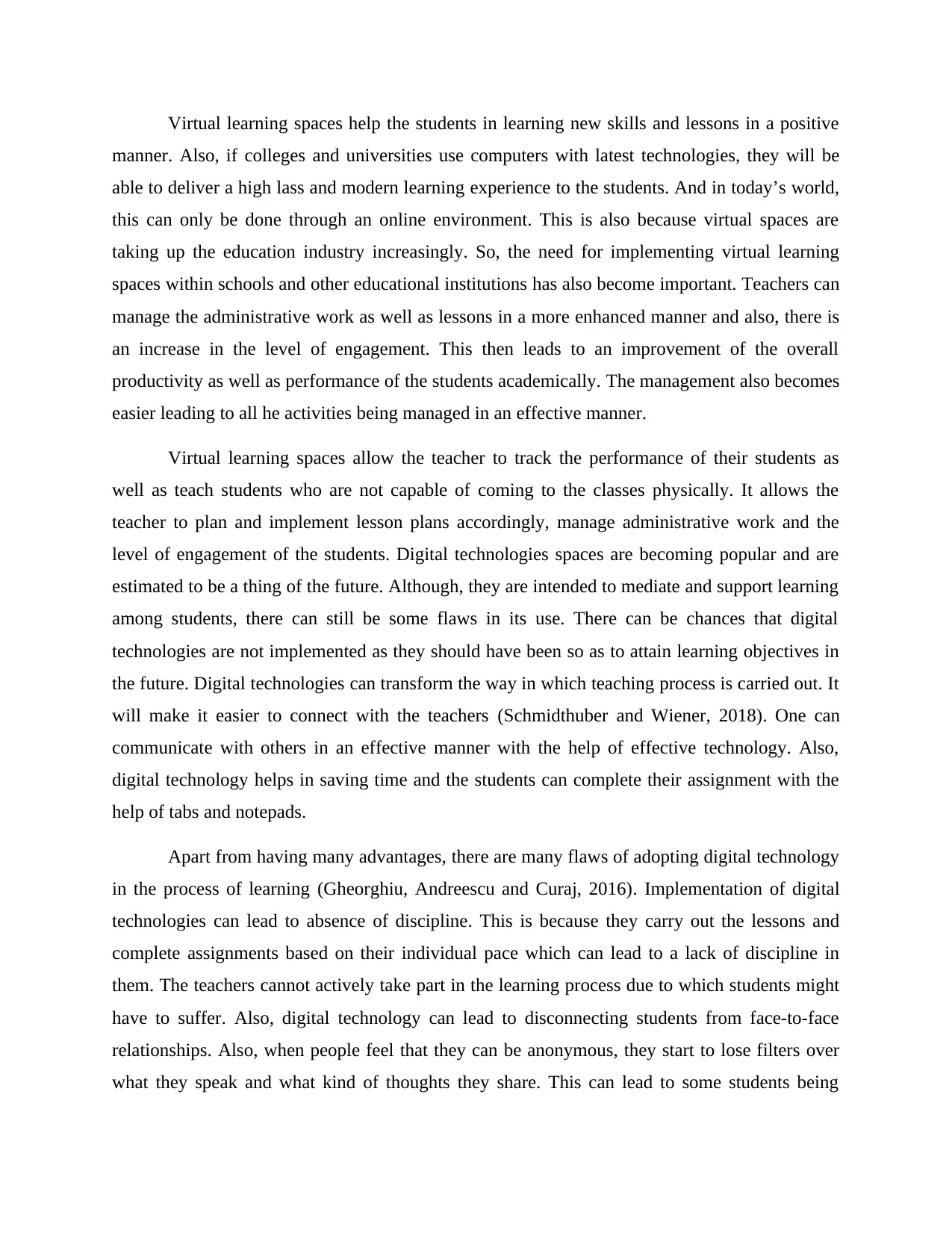
Virtual learning spaces help the students in learning new skills and lessons in a positive
manner. Also, if colleges and universities use computers with latest technologies, they will be
able to deliver a high lass and modern learning experience to the students. And in today’s world,
this can only be done through an online environment. This is also because virtual spaces are
taking up the education industry increasingly. So, the need for implementing virtual learning
spaces within schools and other educational institutions has also become important. Teachers can
manage the administrative work as well as lessons in a more enhanced manner and also, there is
an increase in the level of engagement. This then leads to an improvement of the overall
productivity as well as performance of the students academically. The management also becomes
easier leading to all he activities being managed in an effective manner.
Virtual learning spaces allow the teacher to track the performance of their students as
well as teach students who are not capable of coming to the classes physically. It allows the
teacher to plan and implement lesson plans accordingly, manage administrative work and the
level of engagement of the students. Digital technologies spaces are becoming popular and are
estimated to be a thing of the future. Although, they are intended to mediate and support learning
among students, there can still be some flaws in its use. There can be chances that digital
technologies are not implemented as they should have been so as to attain learning objectives in
the future. Digital technologies can transform the way in which teaching process is carried out. It
will make it easier to connect with the teachers (Schmidthuber and Wiener, 2018). One can
communicate with others in an effective manner with the help of effective technology. Also,
digital technology helps in saving time and the students can complete their assignment with the
help of tabs and notepads.
Apart from having many advantages, there are many flaws of adopting digital technology
in the process of learning (Gheorghiu, Andreescu and Curaj, 2016). Implementation of digital
technologies can lead to absence of discipline. This is because they carry out the lessons and
complete assignments based on their individual pace which can lead to a lack of discipline in
them. The teachers cannot actively take part in the learning process due to which students might
have to suffer. Also, digital technology can lead to disconnecting students from face-to-face
relationships. Also, when people feel that they can be anonymous, they start to lose filters over
what they speak and what kind of thoughts they share. This can lead to some students being
manner. Also, if colleges and universities use computers with latest technologies, they will be
able to deliver a high lass and modern learning experience to the students. And in today’s world,
this can only be done through an online environment. This is also because virtual spaces are
taking up the education industry increasingly. So, the need for implementing virtual learning
spaces within schools and other educational institutions has also become important. Teachers can
manage the administrative work as well as lessons in a more enhanced manner and also, there is
an increase in the level of engagement. This then leads to an improvement of the overall
productivity as well as performance of the students academically. The management also becomes
easier leading to all he activities being managed in an effective manner.
Virtual learning spaces allow the teacher to track the performance of their students as
well as teach students who are not capable of coming to the classes physically. It allows the
teacher to plan and implement lesson plans accordingly, manage administrative work and the
level of engagement of the students. Digital technologies spaces are becoming popular and are
estimated to be a thing of the future. Although, they are intended to mediate and support learning
among students, there can still be some flaws in its use. There can be chances that digital
technologies are not implemented as they should have been so as to attain learning objectives in
the future. Digital technologies can transform the way in which teaching process is carried out. It
will make it easier to connect with the teachers (Schmidthuber and Wiener, 2018). One can
communicate with others in an effective manner with the help of effective technology. Also,
digital technology helps in saving time and the students can complete their assignment with the
help of tabs and notepads.
Apart from having many advantages, there are many flaws of adopting digital technology
in the process of learning (Gheorghiu, Andreescu and Curaj, 2016). Implementation of digital
technologies can lead to absence of discipline. This is because they carry out the lessons and
complete assignments based on their individual pace which can lead to a lack of discipline in
them. The teachers cannot actively take part in the learning process due to which students might
have to suffer. Also, digital technology can lead to disconnecting students from face-to-face
relationships. Also, when people feel that they can be anonymous, they start to lose filters over
what they speak and what kind of thoughts they share. This can lead to some students being
Paraphrase This Document
Need a fresh take? Get an instant paraphrase of this document with our AI Paraphraser
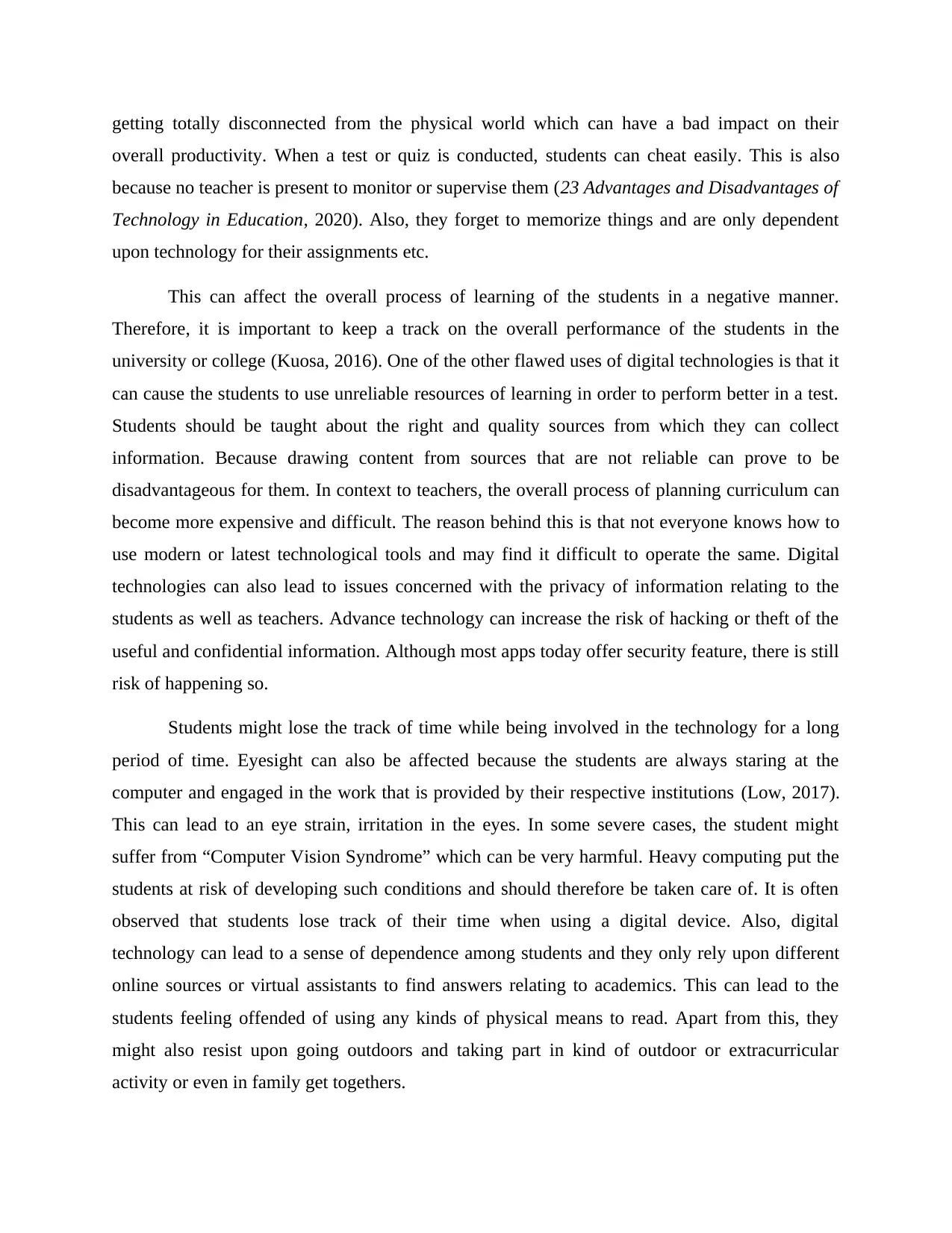
getting totally disconnected from the physical world which can have a bad impact on their
overall productivity. When a test or quiz is conducted, students can cheat easily. This is also
because no teacher is present to monitor or supervise them (23 Advantages and Disadvantages of
Technology in Education, 2020). Also, they forget to memorize things and are only dependent
upon technology for their assignments etc.
This can affect the overall process of learning of the students in a negative manner.
Therefore, it is important to keep a track on the overall performance of the students in the
university or college (Kuosa, 2016). One of the other flawed uses of digital technologies is that it
can cause the students to use unreliable resources of learning in order to perform better in a test.
Students should be taught about the right and quality sources from which they can collect
information. Because drawing content from sources that are not reliable can prove to be
disadvantageous for them. In context to teachers, the overall process of planning curriculum can
become more expensive and difficult. The reason behind this is that not everyone knows how to
use modern or latest technological tools and may find it difficult to operate the same. Digital
technologies can also lead to issues concerned with the privacy of information relating to the
students as well as teachers. Advance technology can increase the risk of hacking or theft of the
useful and confidential information. Although most apps today offer security feature, there is still
risk of happening so.
Students might lose the track of time while being involved in the technology for a long
period of time. Eyesight can also be affected because the students are always staring at the
computer and engaged in the work that is provided by their respective institutions (Low, 2017).
This can lead to an eye strain, irritation in the eyes. In some severe cases, the student might
suffer from “Computer Vision Syndrome” which can be very harmful. Heavy computing put the
students at risk of developing such conditions and should therefore be taken care of. It is often
observed that students lose track of their time when using a digital device. Also, digital
technology can lead to a sense of dependence among students and they only rely upon different
online sources or virtual assistants to find answers relating to academics. This can lead to the
students feeling offended of using any kinds of physical means to read. Apart from this, they
might also resist upon going outdoors and taking part in kind of outdoor or extracurricular
activity or even in family get togethers.
overall productivity. When a test or quiz is conducted, students can cheat easily. This is also
because no teacher is present to monitor or supervise them (23 Advantages and Disadvantages of
Technology in Education, 2020). Also, they forget to memorize things and are only dependent
upon technology for their assignments etc.
This can affect the overall process of learning of the students in a negative manner.
Therefore, it is important to keep a track on the overall performance of the students in the
university or college (Kuosa, 2016). One of the other flawed uses of digital technologies is that it
can cause the students to use unreliable resources of learning in order to perform better in a test.
Students should be taught about the right and quality sources from which they can collect
information. Because drawing content from sources that are not reliable can prove to be
disadvantageous for them. In context to teachers, the overall process of planning curriculum can
become more expensive and difficult. The reason behind this is that not everyone knows how to
use modern or latest technological tools and may find it difficult to operate the same. Digital
technologies can also lead to issues concerned with the privacy of information relating to the
students as well as teachers. Advance technology can increase the risk of hacking or theft of the
useful and confidential information. Although most apps today offer security feature, there is still
risk of happening so.
Students might lose the track of time while being involved in the technology for a long
period of time. Eyesight can also be affected because the students are always staring at the
computer and engaged in the work that is provided by their respective institutions (Low, 2017).
This can lead to an eye strain, irritation in the eyes. In some severe cases, the student might
suffer from “Computer Vision Syndrome” which can be very harmful. Heavy computing put the
students at risk of developing such conditions and should therefore be taken care of. It is often
observed that students lose track of their time when using a digital device. Also, digital
technology can lead to a sense of dependence among students and they only rely upon different
online sources or virtual assistants to find answers relating to academics. This can lead to the
students feeling offended of using any kinds of physical means to read. Apart from this, they
might also resist upon going outdoors and taking part in kind of outdoor or extracurricular
activity or even in family get togethers.
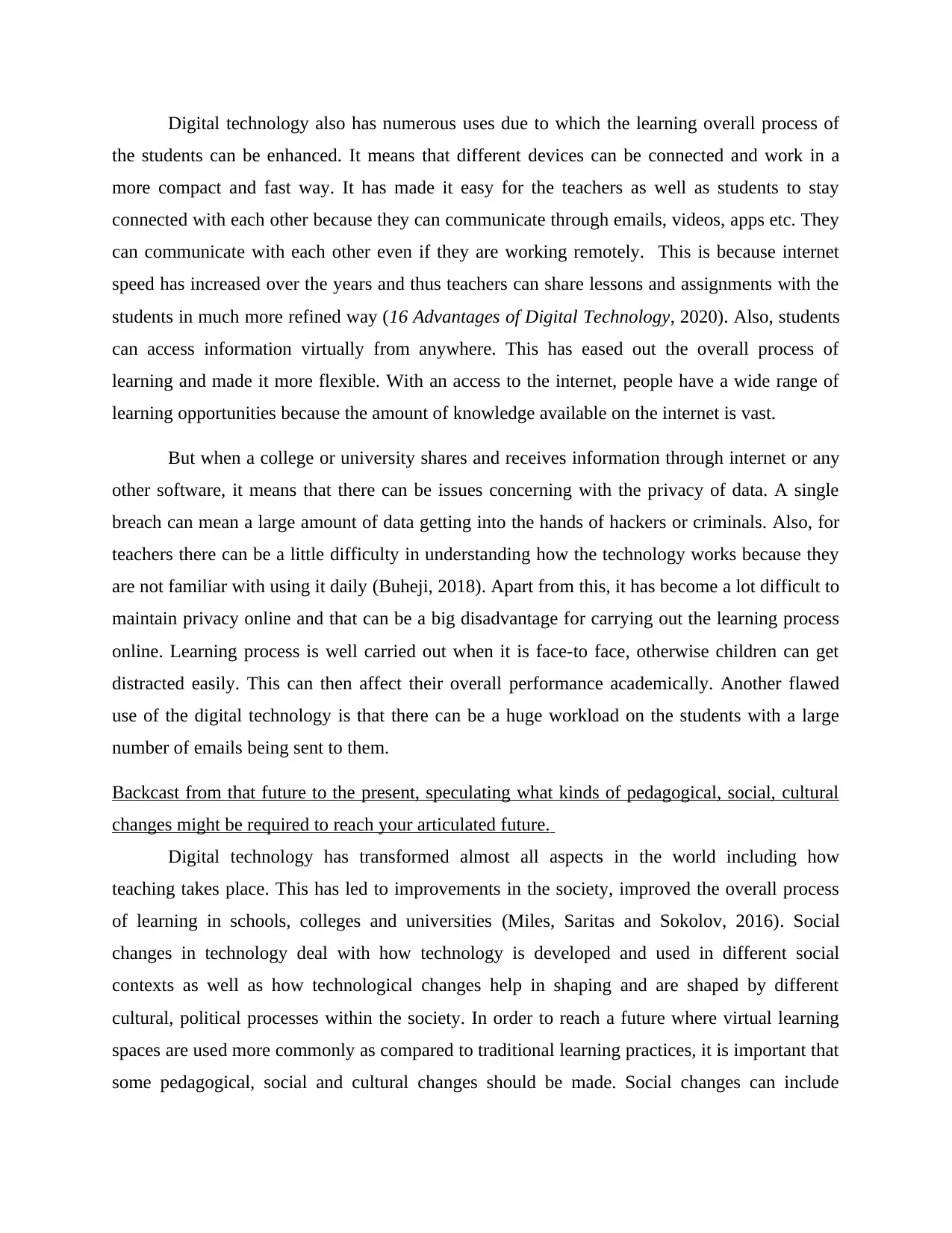
Digital technology also has numerous uses due to which the learning overall process of
the students can be enhanced. It means that different devices can be connected and work in a
more compact and fast way. It has made it easy for the teachers as well as students to stay
connected with each other because they can communicate through emails, videos, apps etc. They
can communicate with each other even if they are working remotely. This is because internet
speed has increased over the years and thus teachers can share lessons and assignments with the
students in much more refined way (16 Advantages of Digital Technology, 2020). Also, students
can access information virtually from anywhere. This has eased out the overall process of
learning and made it more flexible. With an access to the internet, people have a wide range of
learning opportunities because the amount of knowledge available on the internet is vast.
But when a college or university shares and receives information through internet or any
other software, it means that there can be issues concerning with the privacy of data. A single
breach can mean a large amount of data getting into the hands of hackers or criminals. Also, for
teachers there can be a little difficulty in understanding how the technology works because they
are not familiar with using it daily (Buheji, 2018). Apart from this, it has become a lot difficult to
maintain privacy online and that can be a big disadvantage for carrying out the learning process
online. Learning process is well carried out when it is face-to face, otherwise children can get
distracted easily. This can then affect their overall performance academically. Another flawed
use of the digital technology is that there can be a huge workload on the students with a large
number of emails being sent to them.
Backcast from that future to the present, speculating what kinds of pedagogical, social, cultural
changes might be required to reach your articulated future.
Digital technology has transformed almost all aspects in the world including how
teaching takes place. This has led to improvements in the society, improved the overall process
of learning in schools, colleges and universities (Miles, Saritas and Sokolov, 2016). Social
changes in technology deal with how technology is developed and used in different social
contexts as well as how technological changes help in shaping and are shaped by different
cultural, political processes within the society. In order to reach a future where virtual learning
spaces are used more commonly as compared to traditional learning practices, it is important that
some pedagogical, social and cultural changes should be made. Social changes can include
the students can be enhanced. It means that different devices can be connected and work in a
more compact and fast way. It has made it easy for the teachers as well as students to stay
connected with each other because they can communicate through emails, videos, apps etc. They
can communicate with each other even if they are working remotely. This is because internet
speed has increased over the years and thus teachers can share lessons and assignments with the
students in much more refined way (16 Advantages of Digital Technology, 2020). Also, students
can access information virtually from anywhere. This has eased out the overall process of
learning and made it more flexible. With an access to the internet, people have a wide range of
learning opportunities because the amount of knowledge available on the internet is vast.
But when a college or university shares and receives information through internet or any
other software, it means that there can be issues concerning with the privacy of data. A single
breach can mean a large amount of data getting into the hands of hackers or criminals. Also, for
teachers there can be a little difficulty in understanding how the technology works because they
are not familiar with using it daily (Buheji, 2018). Apart from this, it has become a lot difficult to
maintain privacy online and that can be a big disadvantage for carrying out the learning process
online. Learning process is well carried out when it is face-to face, otherwise children can get
distracted easily. This can then affect their overall performance academically. Another flawed
use of the digital technology is that there can be a huge workload on the students with a large
number of emails being sent to them.
Backcast from that future to the present, speculating what kinds of pedagogical, social, cultural
changes might be required to reach your articulated future.
Digital technology has transformed almost all aspects in the world including how
teaching takes place. This has led to improvements in the society, improved the overall process
of learning in schools, colleges and universities (Miles, Saritas and Sokolov, 2016). Social
changes in technology deal with how technology is developed and used in different social
contexts as well as how technological changes help in shaping and are shaped by different
cultural, political processes within the society. In order to reach a future where virtual learning
spaces are used more commonly as compared to traditional learning practices, it is important that
some pedagogical, social and cultural changes should be made. Social changes can include
⊘ This is a preview!⊘
Do you want full access?
Subscribe today to unlock all pages.

Trusted by 1+ million students worldwide
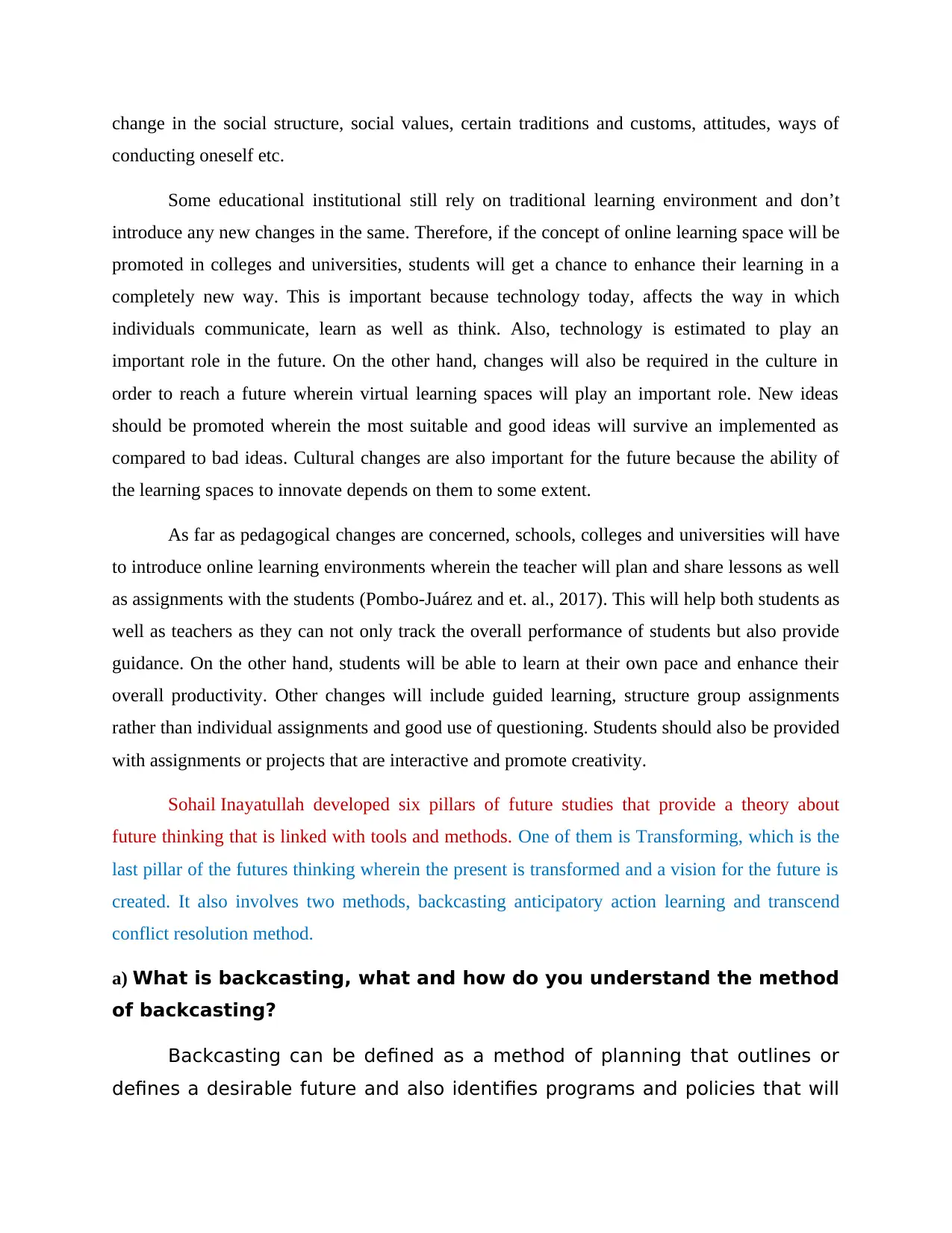
change in the social structure, social values, certain traditions and customs, attitudes, ways of
conducting oneself etc.
Some educational institutional still rely on traditional learning environment and don’t
introduce any new changes in the same. Therefore, if the concept of online learning space will be
promoted in colleges and universities, students will get a chance to enhance their learning in a
completely new way. This is important because technology today, affects the way in which
individuals communicate, learn as well as think. Also, technology is estimated to play an
important role in the future. On the other hand, changes will also be required in the culture in
order to reach a future wherein virtual learning spaces will play an important role. New ideas
should be promoted wherein the most suitable and good ideas will survive an implemented as
compared to bad ideas. Cultural changes are also important for the future because the ability of
the learning spaces to innovate depends on them to some extent.
As far as pedagogical changes are concerned, schools, colleges and universities will have
to introduce online learning environments wherein the teacher will plan and share lessons as well
as assignments with the students (Pombo-Juárez and et. al., 2017). This will help both students as
well as teachers as they can not only track the overall performance of students but also provide
guidance. On the other hand, students will be able to learn at their own pace and enhance their
overall productivity. Other changes will include guided learning, structure group assignments
rather than individual assignments and good use of questioning. Students should also be provided
with assignments or projects that are interactive and promote creativity.
Sohail Inayatullah developed six pillars of future studies that provide a theory about
future thinking that is linked with tools and methods. One of them is Transforming, which is the
last pillar of the futures thinking wherein the present is transformed and a vision for the future is
created. It also involves two methods, backcasting anticipatory action learning and transcend
conflict resolution method.
a) What is backcasting, what and how do you understand the method
of backcasting?
Backcasting can be defined as a method of planning that outlines or
defines a desirable future and also identifies programs and policies that will
conducting oneself etc.
Some educational institutional still rely on traditional learning environment and don’t
introduce any new changes in the same. Therefore, if the concept of online learning space will be
promoted in colleges and universities, students will get a chance to enhance their learning in a
completely new way. This is important because technology today, affects the way in which
individuals communicate, learn as well as think. Also, technology is estimated to play an
important role in the future. On the other hand, changes will also be required in the culture in
order to reach a future wherein virtual learning spaces will play an important role. New ideas
should be promoted wherein the most suitable and good ideas will survive an implemented as
compared to bad ideas. Cultural changes are also important for the future because the ability of
the learning spaces to innovate depends on them to some extent.
As far as pedagogical changes are concerned, schools, colleges and universities will have
to introduce online learning environments wherein the teacher will plan and share lessons as well
as assignments with the students (Pombo-Juárez and et. al., 2017). This will help both students as
well as teachers as they can not only track the overall performance of students but also provide
guidance. On the other hand, students will be able to learn at their own pace and enhance their
overall productivity. Other changes will include guided learning, structure group assignments
rather than individual assignments and good use of questioning. Students should also be provided
with assignments or projects that are interactive and promote creativity.
Sohail Inayatullah developed six pillars of future studies that provide a theory about
future thinking that is linked with tools and methods. One of them is Transforming, which is the
last pillar of the futures thinking wherein the present is transformed and a vision for the future is
created. It also involves two methods, backcasting anticipatory action learning and transcend
conflict resolution method.
a) What is backcasting, what and how do you understand the method
of backcasting?
Backcasting can be defined as a method of planning that outlines or
defines a desirable future and also identifies programs and policies that will
Paraphrase This Document
Need a fresh take? Get an instant paraphrase of this document with our AI Paraphraser
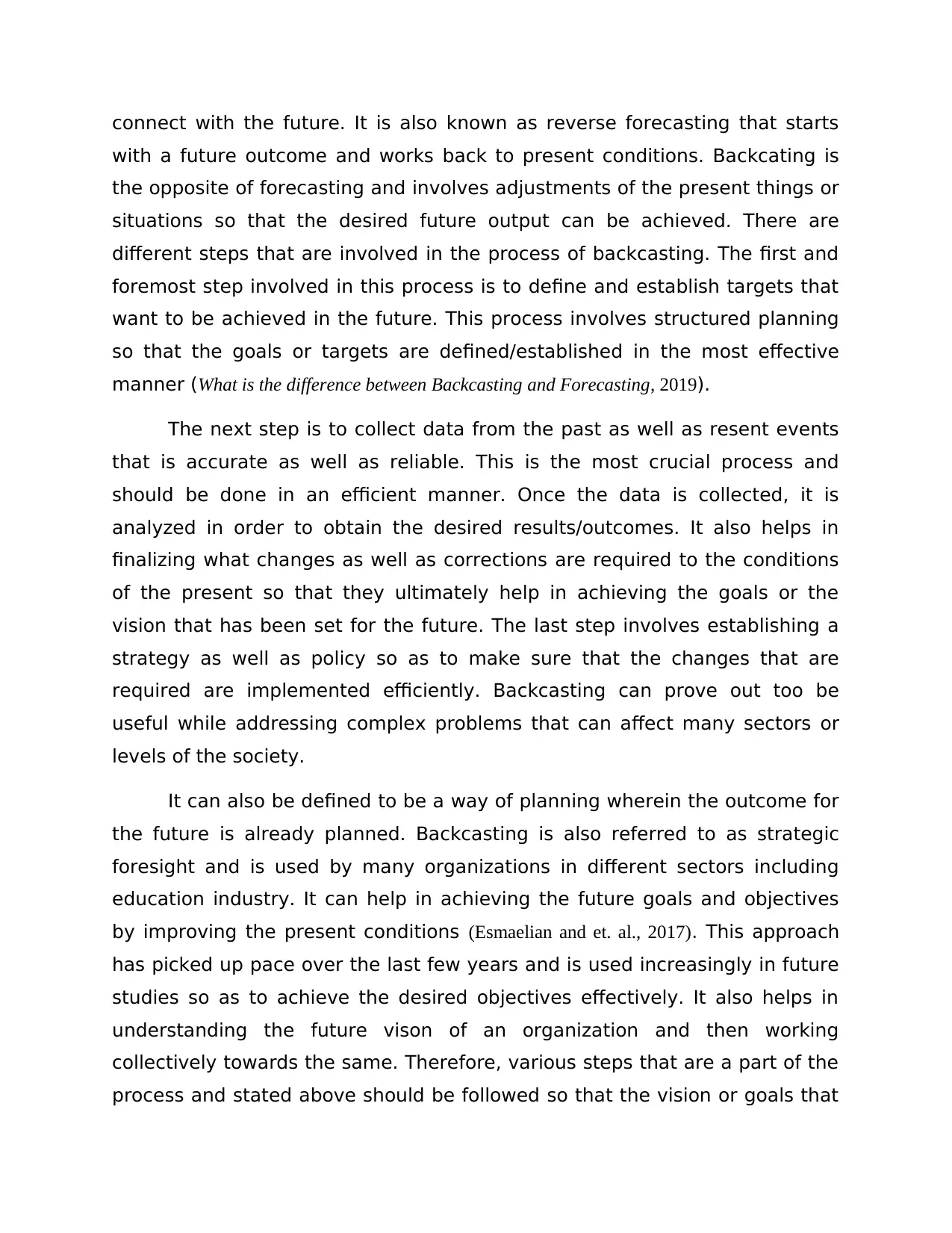
connect with the future. It is also known as reverse forecasting that starts
with a future outcome and works back to present conditions. Backcating is
the opposite of forecasting and involves adjustments of the present things or
situations so that the desired future output can be achieved. There are
different steps that are involved in the process of backcasting. The first and
foremost step involved in this process is to define and establish targets that
want to be achieved in the future. This process involves structured planning
so that the goals or targets are defined/established in the most effective
manner (What is the difference between Backcasting and Forecasting, 2019).
The next step is to collect data from the past as well as resent events
that is accurate as well as reliable. This is the most crucial process and
should be done in an efficient manner. Once the data is collected, it is
analyzed in order to obtain the desired results/outcomes. It also helps in
finalizing what changes as well as corrections are required to the conditions
of the present so that they ultimately help in achieving the goals or the
vision that has been set for the future. The last step involves establishing a
strategy as well as policy so as to make sure that the changes that are
required are implemented efficiently. Backcasting can prove out too be
useful while addressing complex problems that can affect many sectors or
levels of the society.
It can also be defined to be a way of planning wherein the outcome for
the future is already planned. Backcasting is also referred to as strategic
foresight and is used by many organizations in different sectors including
education industry. It can help in achieving the future goals and objectives
by improving the present conditions (Esmaelian and et. al., 2017). This approach
has picked up pace over the last few years and is used increasingly in future
studies so as to achieve the desired objectives effectively. It also helps in
understanding the future vison of an organization and then working
collectively towards the same. Therefore, various steps that are a part of the
process and stated above should be followed so that the vision or goals that
with a future outcome and works back to present conditions. Backcating is
the opposite of forecasting and involves adjustments of the present things or
situations so that the desired future output can be achieved. There are
different steps that are involved in the process of backcasting. The first and
foremost step involved in this process is to define and establish targets that
want to be achieved in the future. This process involves structured planning
so that the goals or targets are defined/established in the most effective
manner (What is the difference between Backcasting and Forecasting, 2019).
The next step is to collect data from the past as well as resent events
that is accurate as well as reliable. This is the most crucial process and
should be done in an efficient manner. Once the data is collected, it is
analyzed in order to obtain the desired results/outcomes. It also helps in
finalizing what changes as well as corrections are required to the conditions
of the present so that they ultimately help in achieving the goals or the
vision that has been set for the future. The last step involves establishing a
strategy as well as policy so as to make sure that the changes that are
required are implemented efficiently. Backcasting can prove out too be
useful while addressing complex problems that can affect many sectors or
levels of the society.
It can also be defined to be a way of planning wherein the outcome for
the future is already planned. Backcasting is also referred to as strategic
foresight and is used by many organizations in different sectors including
education industry. It can help in achieving the future goals and objectives
by improving the present conditions (Esmaelian and et. al., 2017). This approach
has picked up pace over the last few years and is used increasingly in future
studies so as to achieve the desired objectives effectively. It also helps in
understanding the future vison of an organization and then working
collectively towards the same. Therefore, various steps that are a part of the
process and stated above should be followed so that the vision or goals that
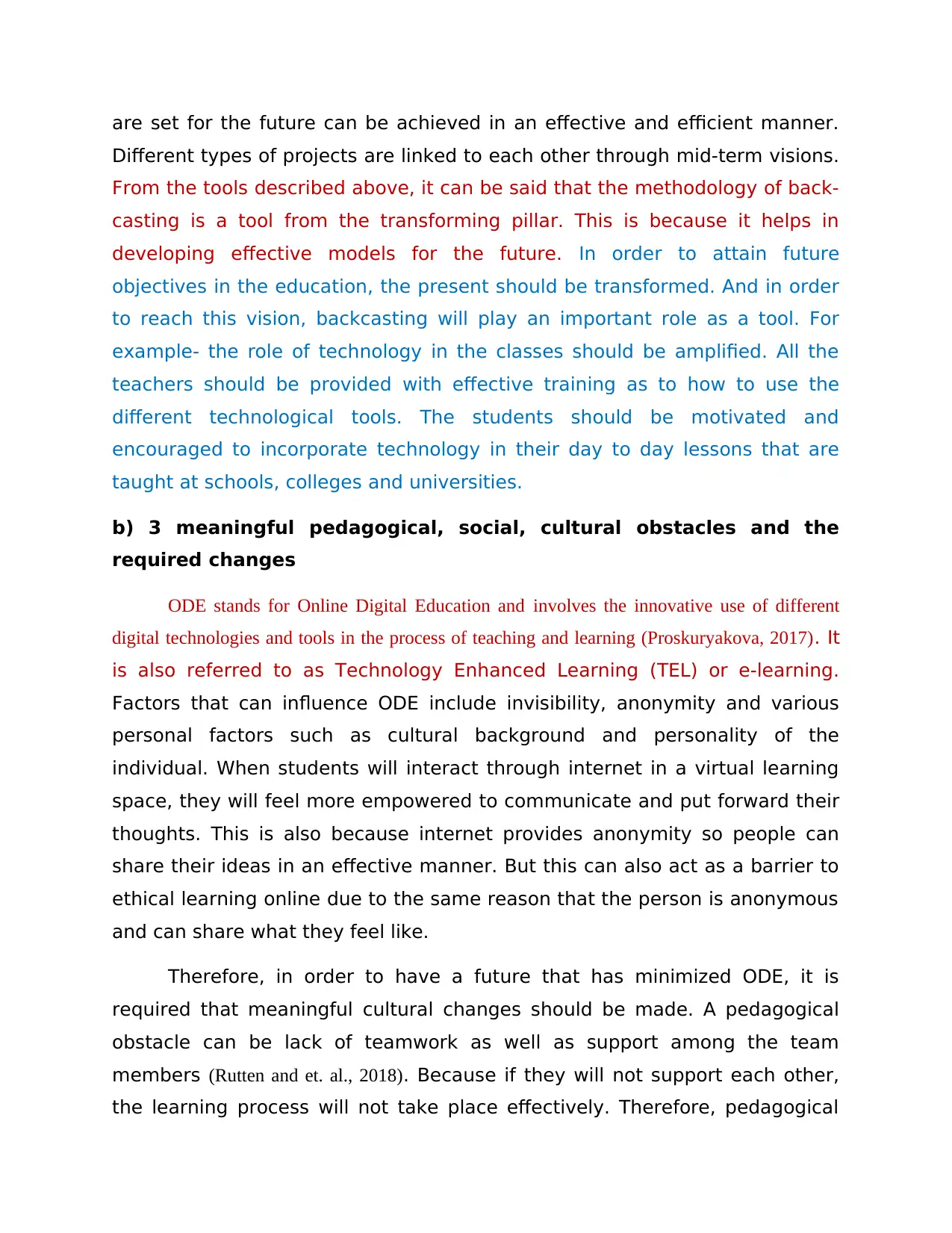
are set for the future can be achieved in an effective and efficient manner.
Different types of projects are linked to each other through mid-term visions.
From the tools described above, it can be said that the methodology of back-
casting is a tool from the transforming pillar. This is because it helps in
developing effective models for the future. In order to attain future
objectives in the education, the present should be transformed. And in order
to reach this vision, backcasting will play an important role as a tool. For
example- the role of technology in the classes should be amplified. All the
teachers should be provided with effective training as to how to use the
different technological tools. The students should be motivated and
encouraged to incorporate technology in their day to day lessons that are
taught at schools, colleges and universities.
b) 3 meaningful pedagogical, social, cultural obstacles and the
required changes
ODE stands for Online Digital Education and involves the innovative use of different
digital technologies and tools in the process of teaching and learning (Proskuryakova, 2017). It
is also referred to as Technology Enhanced Learning (TEL) or e-learning.
Factors that can influence ODE include invisibility, anonymity and various
personal factors such as cultural background and personality of the
individual. When students will interact through internet in a virtual learning
space, they will feel more empowered to communicate and put forward their
thoughts. This is also because internet provides anonymity so people can
share their ideas in an effective manner. But this can also act as a barrier to
ethical learning online due to the same reason that the person is anonymous
and can share what they feel like.
Therefore, in order to have a future that has minimized ODE, it is
required that meaningful cultural changes should be made. A pedagogical
obstacle can be lack of teamwork as well as support among the team
members (Rutten and et. al., 2018). Because if they will not support each other,
the learning process will not take place effectively. Therefore, pedagogical
Different types of projects are linked to each other through mid-term visions.
From the tools described above, it can be said that the methodology of back-
casting is a tool from the transforming pillar. This is because it helps in
developing effective models for the future. In order to attain future
objectives in the education, the present should be transformed. And in order
to reach this vision, backcasting will play an important role as a tool. For
example- the role of technology in the classes should be amplified. All the
teachers should be provided with effective training as to how to use the
different technological tools. The students should be motivated and
encouraged to incorporate technology in their day to day lessons that are
taught at schools, colleges and universities.
b) 3 meaningful pedagogical, social, cultural obstacles and the
required changes
ODE stands for Online Digital Education and involves the innovative use of different
digital technologies and tools in the process of teaching and learning (Proskuryakova, 2017). It
is also referred to as Technology Enhanced Learning (TEL) or e-learning.
Factors that can influence ODE include invisibility, anonymity and various
personal factors such as cultural background and personality of the
individual. When students will interact through internet in a virtual learning
space, they will feel more empowered to communicate and put forward their
thoughts. This is also because internet provides anonymity so people can
share their ideas in an effective manner. But this can also act as a barrier to
ethical learning online due to the same reason that the person is anonymous
and can share what they feel like.
Therefore, in order to have a future that has minimized ODE, it is
required that meaningful cultural changes should be made. A pedagogical
obstacle can be lack of teamwork as well as support among the team
members (Rutten and et. al., 2018). Because if they will not support each other,
the learning process will not take place effectively. Therefore, pedagogical
⊘ This is a preview!⊘
Do you want full access?
Subscribe today to unlock all pages.

Trusted by 1+ million students worldwide
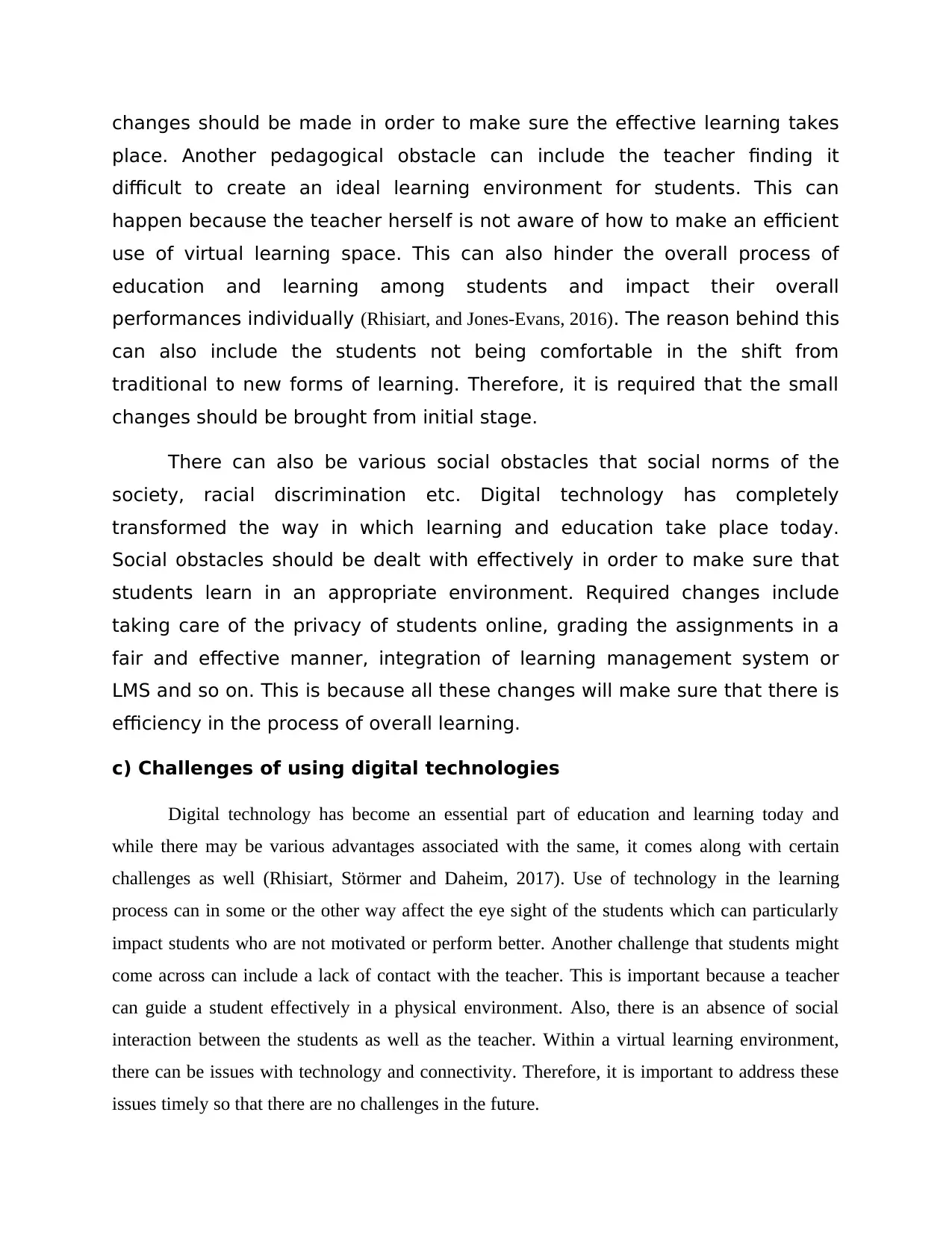
changes should be made in order to make sure the effective learning takes
place. Another pedagogical obstacle can include the teacher finding it
difficult to create an ideal learning environment for students. This can
happen because the teacher herself is not aware of how to make an efficient
use of virtual learning space. This can also hinder the overall process of
education and learning among students and impact their overall
performances individually (Rhisiart, and Jones-Evans, 2016). The reason behind this
can also include the students not being comfortable in the shift from
traditional to new forms of learning. Therefore, it is required that the small
changes should be brought from initial stage.
There can also be various social obstacles that social norms of the
society, racial discrimination etc. Digital technology has completely
transformed the way in which learning and education take place today.
Social obstacles should be dealt with effectively in order to make sure that
students learn in an appropriate environment. Required changes include
taking care of the privacy of students online, grading the assignments in a
fair and effective manner, integration of learning management system or
LMS and so on. This is because all these changes will make sure that there is
efficiency in the process of overall learning.
c) Challenges of using digital technologies
Digital technology has become an essential part of education and learning today and
while there may be various advantages associated with the same, it comes along with certain
challenges as well (Rhisiart, Störmer and Daheim, 2017). Use of technology in the learning
process can in some or the other way affect the eye sight of the students which can particularly
impact students who are not motivated or perform better. Another challenge that students might
come across can include a lack of contact with the teacher. This is important because a teacher
can guide a student effectively in a physical environment. Also, there is an absence of social
interaction between the students as well as the teacher. Within a virtual learning environment,
there can be issues with technology and connectivity. Therefore, it is important to address these
issues timely so that there are no challenges in the future.
place. Another pedagogical obstacle can include the teacher finding it
difficult to create an ideal learning environment for students. This can
happen because the teacher herself is not aware of how to make an efficient
use of virtual learning space. This can also hinder the overall process of
education and learning among students and impact their overall
performances individually (Rhisiart, and Jones-Evans, 2016). The reason behind this
can also include the students not being comfortable in the shift from
traditional to new forms of learning. Therefore, it is required that the small
changes should be brought from initial stage.
There can also be various social obstacles that social norms of the
society, racial discrimination etc. Digital technology has completely
transformed the way in which learning and education take place today.
Social obstacles should be dealt with effectively in order to make sure that
students learn in an appropriate environment. Required changes include
taking care of the privacy of students online, grading the assignments in a
fair and effective manner, integration of learning management system or
LMS and so on. This is because all these changes will make sure that there is
efficiency in the process of overall learning.
c) Challenges of using digital technologies
Digital technology has become an essential part of education and learning today and
while there may be various advantages associated with the same, it comes along with certain
challenges as well (Rhisiart, Störmer and Daheim, 2017). Use of technology in the learning
process can in some or the other way affect the eye sight of the students which can particularly
impact students who are not motivated or perform better. Another challenge that students might
come across can include a lack of contact with the teacher. This is important because a teacher
can guide a student effectively in a physical environment. Also, there is an absence of social
interaction between the students as well as the teacher. Within a virtual learning environment,
there can be issues with technology and connectivity. Therefore, it is important to address these
issues timely so that there are no challenges in the future.
Paraphrase This Document
Need a fresh take? Get an instant paraphrase of this document with our AI Paraphraser
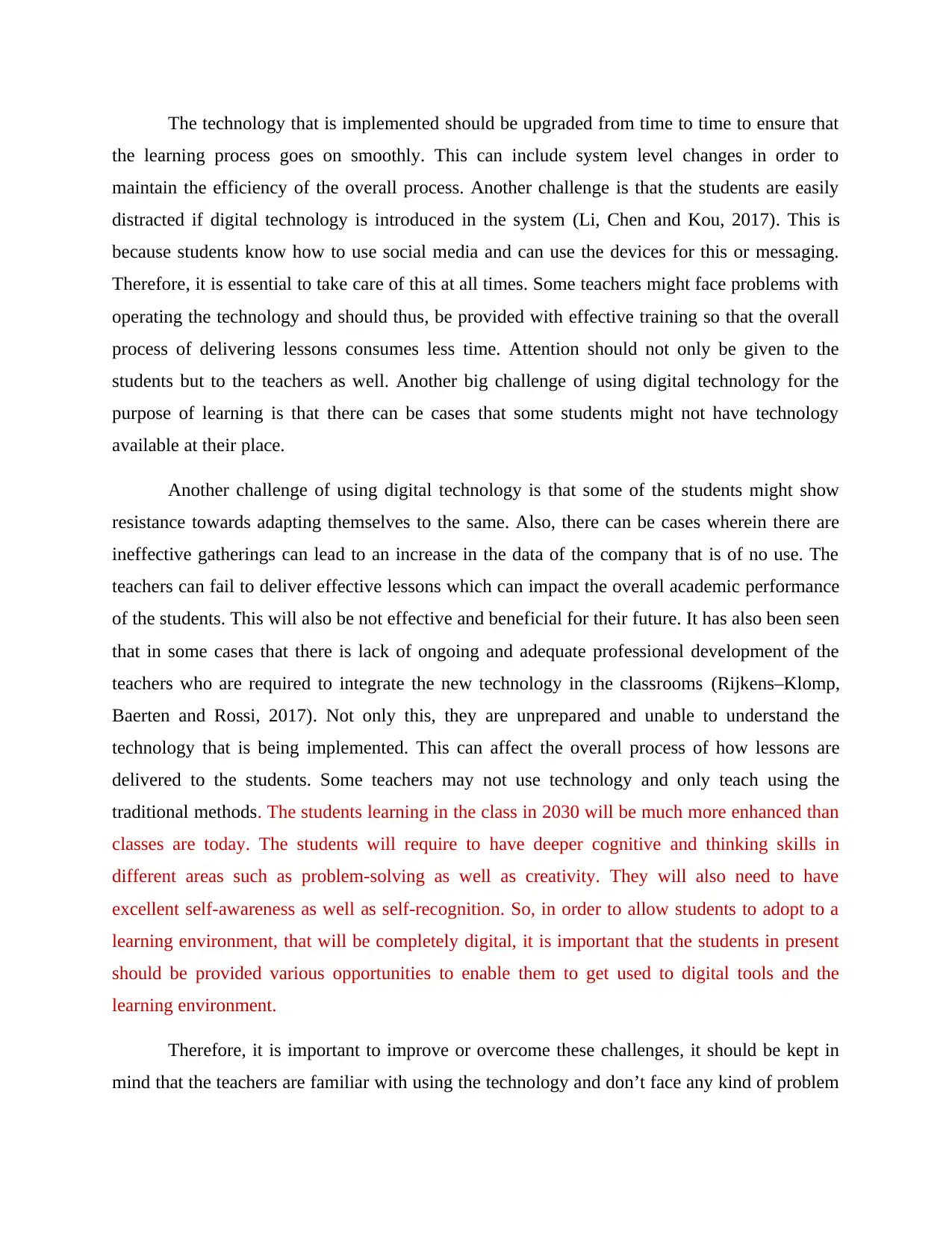
The technology that is implemented should be upgraded from time to time to ensure that
the learning process goes on smoothly. This can include system level changes in order to
maintain the efficiency of the overall process. Another challenge is that the students are easily
distracted if digital technology is introduced in the system (Li, Chen and Kou, 2017). This is
because students know how to use social media and can use the devices for this or messaging.
Therefore, it is essential to take care of this at all times. Some teachers might face problems with
operating the technology and should thus, be provided with effective training so that the overall
process of delivering lessons consumes less time. Attention should not only be given to the
students but to the teachers as well. Another big challenge of using digital technology for the
purpose of learning is that there can be cases that some students might not have technology
available at their place.
Another challenge of using digital technology is that some of the students might show
resistance towards adapting themselves to the same. Also, there can be cases wherein there are
ineffective gatherings can lead to an increase in the data of the company that is of no use. The
teachers can fail to deliver effective lessons which can impact the overall academic performance
of the students. This will also be not effective and beneficial for their future. It has also been seen
that in some cases that there is lack of ongoing and adequate professional development of the
teachers who are required to integrate the new technology in the classrooms (Rijkens–Klomp,
Baerten and Rossi, 2017). Not only this, they are unprepared and unable to understand the
technology that is being implemented. This can affect the overall process of how lessons are
delivered to the students. Some teachers may not use technology and only teach using the
traditional methods. The students learning in the class in 2030 will be much more enhanced than
classes are today. The students will require to have deeper cognitive and thinking skills in
different areas such as problem-solving as well as creativity. They will also need to have
excellent self-awareness as well as self-recognition. So, in order to allow students to adopt to a
learning environment, that will be completely digital, it is important that the students in present
should be provided various opportunities to enable them to get used to digital tools and the
learning environment.
Therefore, it is important to improve or overcome these challenges, it should be kept in
mind that the teachers are familiar with using the technology and don’t face any kind of problem
the learning process goes on smoothly. This can include system level changes in order to
maintain the efficiency of the overall process. Another challenge is that the students are easily
distracted if digital technology is introduced in the system (Li, Chen and Kou, 2017). This is
because students know how to use social media and can use the devices for this or messaging.
Therefore, it is essential to take care of this at all times. Some teachers might face problems with
operating the technology and should thus, be provided with effective training so that the overall
process of delivering lessons consumes less time. Attention should not only be given to the
students but to the teachers as well. Another big challenge of using digital technology for the
purpose of learning is that there can be cases that some students might not have technology
available at their place.
Another challenge of using digital technology is that some of the students might show
resistance towards adapting themselves to the same. Also, there can be cases wherein there are
ineffective gatherings can lead to an increase in the data of the company that is of no use. The
teachers can fail to deliver effective lessons which can impact the overall academic performance
of the students. This will also be not effective and beneficial for their future. It has also been seen
that in some cases that there is lack of ongoing and adequate professional development of the
teachers who are required to integrate the new technology in the classrooms (Rijkens–Klomp,
Baerten and Rossi, 2017). Not only this, they are unprepared and unable to understand the
technology that is being implemented. This can affect the overall process of how lessons are
delivered to the students. Some teachers may not use technology and only teach using the
traditional methods. The students learning in the class in 2030 will be much more enhanced than
classes are today. The students will require to have deeper cognitive and thinking skills in
different areas such as problem-solving as well as creativity. They will also need to have
excellent self-awareness as well as self-recognition. So, in order to allow students to adopt to a
learning environment, that will be completely digital, it is important that the students in present
should be provided various opportunities to enable them to get used to digital tools and the
learning environment.
Therefore, it is important to improve or overcome these challenges, it should be kept in
mind that the teachers are familiar with using the technology and don’t face any kind of problem
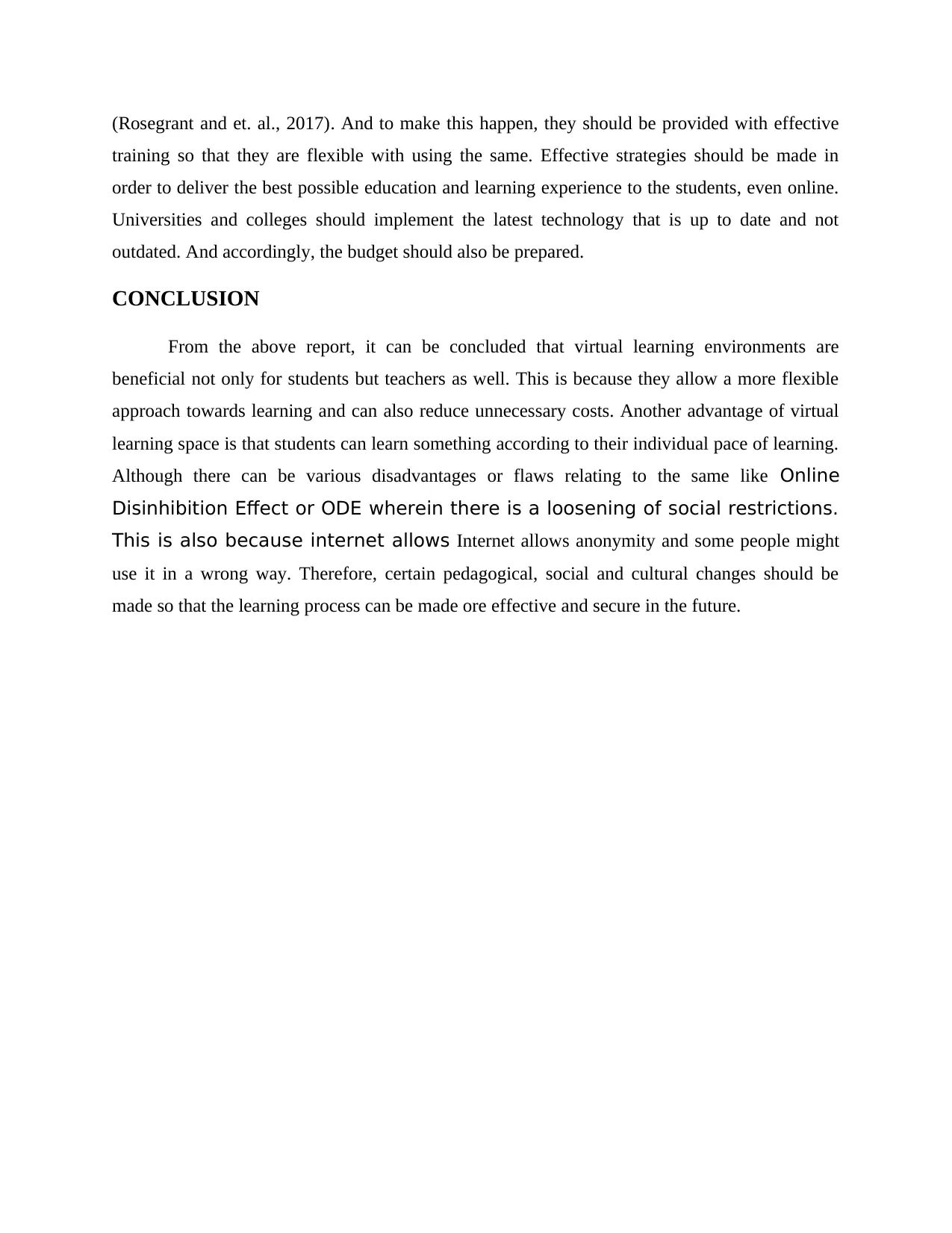
(Rosegrant and et. al., 2017). And to make this happen, they should be provided with effective
training so that they are flexible with using the same. Effective strategies should be made in
order to deliver the best possible education and learning experience to the students, even online.
Universities and colleges should implement the latest technology that is up to date and not
outdated. And accordingly, the budget should also be prepared.
CONCLUSION
From the above report, it can be concluded that virtual learning environments are
beneficial not only for students but teachers as well. This is because they allow a more flexible
approach towards learning and can also reduce unnecessary costs. Another advantage of virtual
learning space is that students can learn something according to their individual pace of learning.
Although there can be various disadvantages or flaws relating to the same like Online
Disinhibition Effect or ODE wherein there is a loosening of social restrictions.
This is also because internet allows Internet allows anonymity and some people might
use it in a wrong way. Therefore, certain pedagogical, social and cultural changes should be
made so that the learning process can be made ore effective and secure in the future.
training so that they are flexible with using the same. Effective strategies should be made in
order to deliver the best possible education and learning experience to the students, even online.
Universities and colleges should implement the latest technology that is up to date and not
outdated. And accordingly, the budget should also be prepared.
CONCLUSION
From the above report, it can be concluded that virtual learning environments are
beneficial not only for students but teachers as well. This is because they allow a more flexible
approach towards learning and can also reduce unnecessary costs. Another advantage of virtual
learning space is that students can learn something according to their individual pace of learning.
Although there can be various disadvantages or flaws relating to the same like Online
Disinhibition Effect or ODE wherein there is a loosening of social restrictions.
This is also because internet allows Internet allows anonymity and some people might
use it in a wrong way. Therefore, certain pedagogical, social and cultural changes should be
made so that the learning process can be made ore effective and secure in the future.
⊘ This is a preview!⊘
Do you want full access?
Subscribe today to unlock all pages.

Trusted by 1+ million students worldwide
1 out of 14
Related Documents
Your All-in-One AI-Powered Toolkit for Academic Success.
+13062052269
info@desklib.com
Available 24*7 on WhatsApp / Email
![[object Object]](/_next/static/media/star-bottom.7253800d.svg)
Unlock your academic potential
Copyright © 2020–2025 A2Z Services. All Rights Reserved. Developed and managed by ZUCOL.





